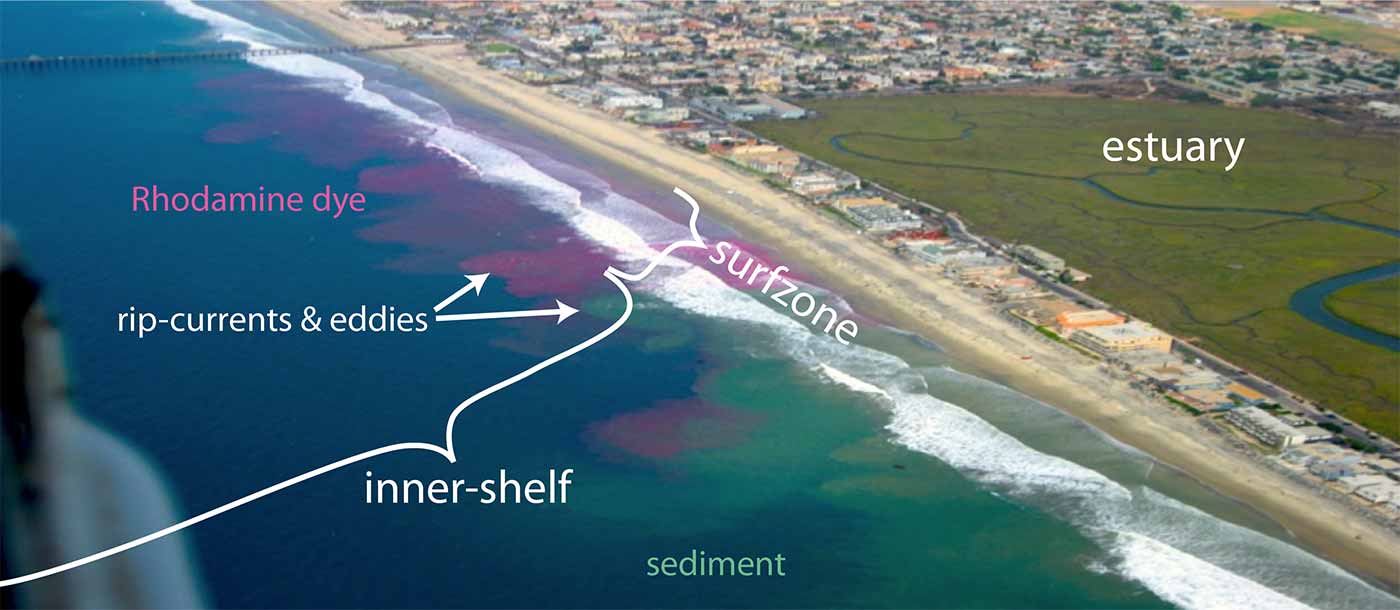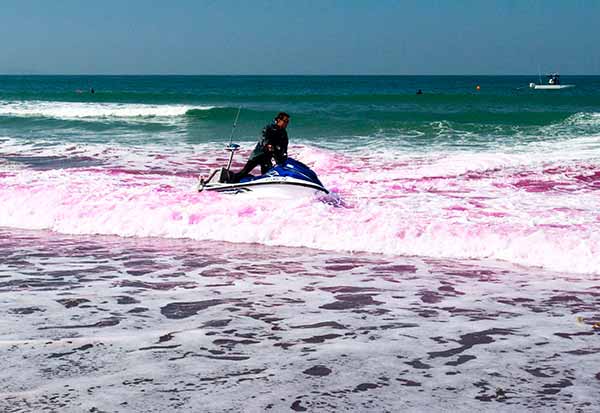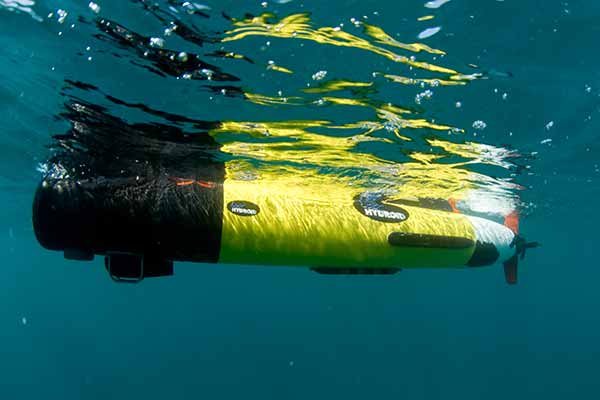UC San Diego Among Multidisciplinary Awards Providing $221M Nationally for Cutting-Edge Projects
Technology & Engineering

During the 2015 Cross Surfzone/Inner-shelf Dye Exchange (CSIDE) project (as in 2009, shown on map), researchers will release non-toxic bright pink fluorescent dye into beach waters and track its movements along the coast.
In an ambitious binational effort to investigate how pollution and other contaminants travel across and along beach waters, scientists from both sides of the border are leading a novel experiment at Imperial Beach and Coronado (south of San Diego), Calif., and Tijuana, Mexico. The National Science Foundation-funded project includes researchers from UC San Diego’s Scripps Institution of Oceanography, Jacobs School of Engineering, and several Mexican institutions.
During the Cross Surfzone/Inner-shelf Dye Exchange (CSIDE) project, from Sept. 22 to Oct. 17, researchers will perform three experiments releasing non-toxic bright pink fluorescent dye into beach waters and track its movements along the coast some 10-20 kilometers (6.2-12.4 miles) for nearly 36 hours. One of the dye releases will be at the southern end of Playas de Tijuana, Mexico. A team of scientists, engineers, and technicians will follow the dye with a variety of instruments to obtain a clearer picture of how pollution moves and dilutes along the coast. With this information, study results will eventually be used by managers and policy makers to guide beach closure decisions and evaluate upstream mitigation possibilities.
Coastal waters are valuable natural resources for food, revenue, recreation, and ecosystems. Unhealthy water conditions due to pathogens, human discharge, and other contaminants threaten water quality along the shoreline. Such adverse conditions were exposed in mid-September when San Diego County beaches from the Mexican border to Coronado were closed due to pollutants flooding into the ocean from heavy rain.

Similar to the Imperial Beach Pollutant Transport and Dilution Experiment in 2009 (shown), researchers will use Jet Skis to track pink dye during the 2015 Cross Surfzone/Inner-shelf Dye Exchange (CSIDE) project.
“The U.S. population is concentrated at the coasts. Despite the importance of clean coastal waters to our economy and well-being, declining water quality from pollutants, such as sewage, entering the ocean threatens coastal ecosystems and human health,” said Falk Feddersen, a Scripps Oceanography professor and a CSIDE project leader. “By tracking dye released both north and south of the border, we can understand the rate of pollutant transport along the coast, how it dilutes, and learn how to develop accurate models for when it will be okay or not to go in the ocean— similar to weather models.”
The pink dye will be tracked at the shoreline, from boats, and from a Jet ski with an instrument called a fluorometer that measures the dye fluorescence. The dye will also be measured from a plane with a hyperspectral sensor that makes detailed measurements of ocean color. Demonstrating the importance of this study, Naval Base Coronado has given the researchers approval to perform dye sampling work on Navy property between Imperial Beach and Coronado and the waters offshore. Supporters also included the cities of Imperial Beach and Coronado, California state parks, and the National Estuarine Research Reserve System.
“This work applies broadly to coastlines around the world and has local relevance to the water quality problems experienced in the San Diego Bight,” said Sarah Giddings, an assistant professor at Scripps and co-leader of CSIDE. “We have developed a binational team of scientists because coastal water quality is not a national issue. Water currents, waves, and watersheds do not follow borders and thus neither do the things carried by the water. This work applies not just to water quality but to transport of other water-borne constituents such as sediment and fish larvae.”

An autonomous underwater vehicle will be used to map dye during CSIDE.
A research team led by mechanical engineering Professor Geno Pawlak also will be using an autonomous underwater vehicle to map the dye dispersal outside of the surf zone at the coast. The team will specifically examine the structure and evolution of large-scale eddies formed by rip currents. Engineers will combine the vehicle’s measurements with traditional fixed sensors that oceanographers have installed in the area where the dye will be released.
“The hypothesis is that these eddies play an important role in the exchange of water between the nearshore region and the shelf,” said Pawlak, who leads a research group at the Jacobs School of Engineering at UC San Diego. “Their longevity and structure can influence transport to and from the shore of nutrients and biology but also potentially pollutants and pathogens.”
CSIDE builds upon the successes of previous beach pollution studies, including the 2009 Imperial Beach Pollutant Transport and Dilution Experiment. The 2015 project expands the scope of study by tracking dye over longer periods of time and across broader stretches of coastline.
The new project is the latest chapter in a foundation of research by Scripps coastal oceanographers built over decades to more fully understand complex processes along the coast. As one example, the Coastal Data Information Program (CDIP), supported by the U.S. Army Corps of Engineers and the California Division of Boating and Waterways,
specializes in wave measurements, wave modeling—including nowcasts and forecasts—and the analysis of coastal environment data. CDIP data are used daily by a vast mix of users, including offshore mariners, harbor masters, coastal managers, and surfers.
CSIDE supporters also include WILDCOAST, Surfrider, San Diego Coastkeeper, YMCA Camp Surf, as well as 25 undergraduate researchers.
Keep up with all the latest from UC San Diego. Subscribe to the newsletter today.